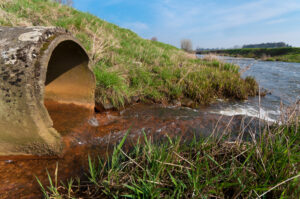
As rain falls it may soak into the ground, land on a tree, a river, a roof, or travel across a driveway or pavement. Any water that does not soak directly into the ground and travels across the landscape is known as stormwater runoff.
The farther and longer this water travels, the more likely it is to pick up whatever is in its path: fertilizer, oil, pesticides, dirt, bacteria and other pollutants, all eventually reaching our bodies of water. According to the Environmental Protection Agency, polluted runoff is one of the greatest threats to clean water in the United States.
Yes there can be many chemicals in stormwater runnoff, but isn’t our water treated? True, however higher levels of chemicals in the water source leads to more time, expense, and headache to treat the water. Additionally, this untreated stormwater may reach bodies of water that we use for swimming, fishing, or other recreation – harming not just us, but the plants and animals living there.
Preventing Stormwater Pollution
Keeping pollutants out of the stormwater runoff is very important, but limiting the installation of impervious surfaces (pavement, pools, roofs) can also help. Imprevious surfaces increase the amount and speed of stormwater runoff as well as decrease the natural features that absorb water (and that may absorb air borne pollants as well!).
Whether you are an individual or a commercial operation, there are many things you can do to prevent harmful stormwater runoff and increase soil infiltration.
If you are a business in a Marion County Wellfield, get started by participating our the FREE and confidential Business Assessment Program. You’ll receive suggestions from a trained environmental professional and possibly receive free pollution prevention equipment.
Commercial
- Sweep up litter and debris from sidewalks, driveways and parking lots, especially around storm drains.
- Use secondary containment equipment for stored chemicals.
- Create an Emergency Response Spill Prevention Plan and train employees how to react and report chemical spills. View ideas and templates
- Divert stormwater away from disturbed or exposed areas of construction sites.
- Control erosion by installing silt fences, vehicle mud removal areas, vegetative cover, and other sediment and erosion controls and properly maintain them, especially after rainstorms.
- Apply fertilizers and pesticides according to label instructions to save money and minimize pollution.
- Properly maintain fleet vehicles to prevent oil, gas, and other discharges.
- Install native plant greenspaces. This not only helps soak up more rain, but can reduce urban heat islands, create habitats for animals, and add to the overall value of your property.
Residential
- Recycle or properly dispose of household products that contain chemicals, such as insecticides, pesticides, paint, solvents, and used motor oil and other auto fluids.
- Use pesticides and fertilizers sparingly and in the recommended amounts. Use organic mulch or safer pest control methods whenever possible.
- Compost or mulch yard waste instead of leaving it in the in the street or sweep into storm drains.
- Use a commercial car wash that treats or recycles its wastewater, or wash your car on your yard so the water infiltrates into the ground.
- When walking your pet, remember to pick up the waste and dispose of it properly (flushing is the best disposal method).
- Use permeable pavement systems on patios, sidewalks, and driveways instead of concrete or asphalt to allow water to soak into the ground.
- Plant native. Not only does this absorb more water, but you will use less to care for the plants.
No matter where you live or what you do – you can take one step today to prevent pollution to our waterways!
